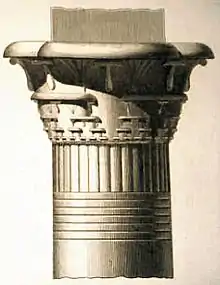康托尔集
在数学中,康托尔集,由德国数学家格奥尔格·康托尔在1883年引入[1][2](但由亨利·约翰·斯蒂芬·史密斯在1875年发现[3][4][5][6]),是位于一条线段上的一些点的集合,具有许多显著和深刻的性质。通过考虑这个集合,康托尔和其他数学家奠定了现代点集拓扑学的基础。虽然康托尔自己用一种一般、抽象的方法定义了这个集合,但是最常见的构造是康托尔三分点集,由去掉一条线段的中间三分之一得出。康托尔自己只附带介绍了三分点集的构造,作为一个更加一般的想法——一个无处稠密的完备集的例子。

カントール集合のような模様がついた柱頭。Jollois, Jean-Baptiste Prosper; Devilliers, Edouard, , Paris: Imprimerie Imperiale, 1809-1828 よりフィラエ島の彫刻
康托尔集的构造
康托尔集是由不断去掉线段的中间三分之一而得出。首先从区间中去掉中间的三分之一(),留下两条线段:。然后,把这两条线段的中间三分之一都去掉,留下四条线段:。把这个过程一直进行下去,其中第个集合为:
康托尔集就是由所有过程中没有被去掉的区间中的点组成。
下面的图显示了这个过程的最初六个步骤。

註釋
- Georg Cantor (1883) "Über unendliche, lineare Punktmannigfaltigkeiten V" [On infinite, linear point-manifolds (sets)],Mathematische Annalen, vol. 21, pages 545–591.
- H.-O. Peitgen, H. Jürgens, and D. Saupe, Chaos and Fractals: New Frontiers of Science 2nd ed. (N.Y., N.Y.: Springer Verlag, 2004), page 65.
- Henry J.S. Smith (1875) “On the integration of discontinuous functions.” Proceedings of the London Mathematical Society, Series 1, vol. 6, pages 140–153.
- “康托尔集”还由Paul du Bois-Reymond发现(1831–1889)。参见:Paul du Bois-Reymond (1880) “Der Beweis des Fundamentalsatzes der Integralrechnung,” Mathematische Annalen, vol. 16, pages 115–128的第128页的脚注。“康托尔集”还由Vito Volterra在1881年发现(1860–1940)。参见:Vito Volterra (1881) “Alcune osservazioni sulle funzioni punteggiate discontinue” [Some observations on point-wise discontinuous functions],Giornale di Matematiche, vol. 19, pages 76–86.
- José Ferreirós, Labyrinth of Thought: A History of Set Theory and Its Role in Modern Mathematics (Basel, Switzerland: Birkhäuser Verlag, 1999), pages 162–165.
- Ian Stewart, Does God Play Dice?: The New Mathematics of Chaos
- Mohsen Soltanifar, On A sequence of cantor Fractals, Rose Hulman Undergraduate Mathematics Journal, Vol 7, No 1, paper 9, 2006.
- Mohsen Soltanifar, A Different Description of A Family of Middle-a Cantor Sets, American Journal of Undergraduate Research, Vol 5, No 2, pp 9–12, 2006.
參考文獻
- Steen, Lynn Arthur; Seebach, J. Arthur Jr., Dover reprint of 1978, Berlin, New York: Springer-Verlag, 1995 [1978], ISBN 978-0-486-68735-3, MR507446 (See example 29).
- Gary L. Wise and Eric B. Hall, Counterexamples in Probability and Real Analysis. Oxford University Press, New York 1993. ISBN 0-19-507068-2. (See chapter 1).
- cut-the-knot上的康托尔集
- cut-the-knot上的康托尔集与函数
外部連結
This article is issued from Wikipedia. The text is licensed under Creative Commons - Attribution - Sharealike. Additional terms may apply for the media files.
